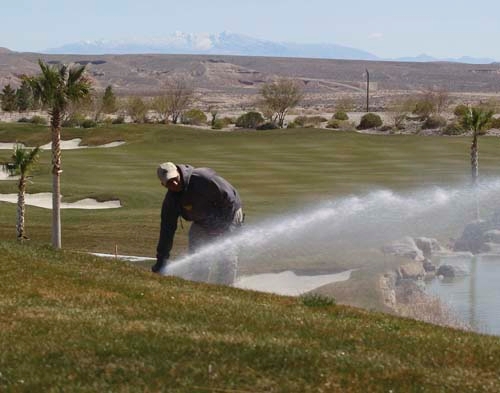Coyote Springs to mark arrival of electric power supply
Developers of Coyote Springs today will flip the switch to bring electric power to the 43,000-acre master-planned community 50 miles northeast of Las Vegas, a significant milestone in the project's development.
Officials from the Lincoln County Power District will join San Francisco-based real estate developers Thomas and Albert Seeno Jr. at the ceremony.
The development, in a remote area about 20 miles west of Moapa, has relied on power from two diesel-powered generators, which are loud and environmentally unfriendly, said Sam Singer, spokesman for the developers.
The supply of clean electric power is needed to run the water and sewer treatment plants, part of $300 million in infrastructure already in place that includes the 4-year-old Coyote Springs Golf Course, Singer said.
The Seeno brothers bought an interest in Wingfield Nevada Holding Group in 2007. Three years later, they bought out embattled developer Harvey Whittemore for $44.5 million to gain 100 percent control of the company.
In January, Wingfield sued Whittemore, charging the former manager with embezzlement and unjust enrichment. But that has nothing to do with development of Coyote Springs, Albert Seeno said Tuesday from Concord, Calif.
Although the first homes are probably three years away from construction, getting the power, water filtration and sewage treatment in place is essential to proceeding on the project, he said.
The Coyote Springs plan dates to 1998. But, like most real estate developments in the past six years, it was stalled by the recession and real estate crisis, which hit Las Vegas particularly hard. With the turn in the economy and a recent upswing in home sales, the developers are optimistic.
"I believe Vegas is pulling out of the doldrums slowly, in baby steps," Seeno said. "For people to move into the community at Coyote Springs, existing homes have to gain a little more in value. Once that takes place, they can move into the new market."
McCarran International Airport is still one of the nation's busiest airports and Las Vegas will continue to be a worldwide destination, regardless of what's happening in real estate, he said. Also, he said, Nevada's business climate is much friendlier than California's.
"It will take a little time, but I don't think it's way out in the future," Seeno said. "Maybe 12, 24, 36 months. All of the permits are in place - the environmental permits, the use permits, the development agreement."
Coyote Springs, nearly twice the size of the master-planned Summerlin community in Las Vegas, is planned for 159,000 homes. Wingfield entered an agreement with Pardee Homes in 2005 to buy about 2,000 acres, and Pardee has shared infrastructure investment costs.
As is often the case with partners in major developments, Wingfield and Pardee have had their differences. Wingfield has a pending lawsuit aimed at keeping Pardee on a rigid time frame for meeting its contractual obligations, Seeno said.
The next step involves Wingfield and Pardee working together to complete the sewer treatment facility, water treatment plant and related distribution lines and infrastructure. Once those projects are complete, developers will be able to obtain building permits and lay the foundation for homes.























